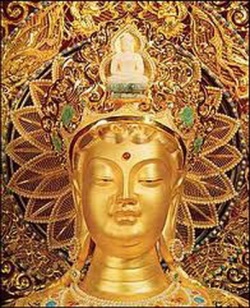Sarvāstivāda
Sarvāstivāda. The school of Sarvāstivāda was one of the so-called Eighteen Schools (nikāya, ācariyavāda) of early Buddhism. The term Sarvāstivāda is also used to designate the body of doctrine and literature associated with this community. The sociological nature of the group, however, remains unknown.
The sociological nature of the group, however, remains unknown.
Historical Development
Although it is customary to refer to the Sarvāstivāda as a Hīnayāna "sect," it seems evident that it was primarily a monastic and intellectual movement—thus the term sect might be inappropriate.
The term Hīnayāna is equally problematic, and in this case it must be taken to establish only a definition by exclusion—"that which is not Mahāyāna."
The Sarvāstivāda was one of the parent lines in the genealogic tree of the Eighteen Schools, consistently identified in traditional doxography as one of the earlier Sthavira groups.
From the Sarvāstivāda arose in turn, according to most accounts, the schools of the Sautrāntika and the Mūlasarvāstivāda, and perhaps that of the Dharmaguptaka.
Existing knowledge of the history and teachings of the early schools is based on late sources, and there is little agreement among scholars as to the true affiliation of the sects mentioned in these sources.
It is not clear, for instance, whether the Mahīśāsaka school should be classified under the Sarvāstivāda or under "mainline" Sthaviras.
There is, nevertheless, agreement among the classical sources on the derivation of the Sarvāstivāda from a main Sthavira trunk, most probably after the great schism that separated the early Sthavira from the Mahāsāṃghika.
The separation of Sarvāstivāda from its trunk of origin is supposed to have taken place at the Third Buddhist Council, held under King Aśoka. They separated from the Sthaviras according to some accounts, from the Mahīśāsaka, according to others.
It is known from inscriptional evidence that the area of greatest strength of the Sarvāstivāda was the Northwest, from Mathura to Afghanistan and the Central Asian desert. But they also were known in East and South India. Their influence extended to Indonesia, and, indirectly, to China.
The Sarvāstivādins received the royal patronage of Kaniṣka (second century ce). According to tradition, the Tripiṭaka of this school was finally closed during his reign. But it is not clear whether this legend is due to a confusion between the writing of their Abhidharma and the compilation of the canon.
It is more likely that most of the Sarvāstivādin Tripiṭaka was redacted earlier, and that by the second century ce Sarvāstivādin scholars were engaged in exegetical work.
This was the time for the major systematic works, and the beginning of the work of synthesis such as would develop into the Mahāvibhāṣā.
As a school of philosophy Sarvāstivāda was gradually absorbed by the Sautrāntika and the Mahāyāna.
But it remained a strong monastic institution, especially in the Northwest. Sarvāstivāda survived at least into the ninth century ce through the Mūlasarvāstivāda subschool.
By counting Mūlasarvāstivādin texts as works of Sarvāstivādin imprint, one can form an approximate idea of the greater part of the Tripiṭaka of this school.
The combined literature of both groups almost constitutes a complete canon, preserved mostly in Chinese and Tibetan translation, but also in several Sanskrit fragments from central Asia.
This body of literature is an important source for the study of the so-called Hīnayāna schools, eclipsed in this respect only by that of the Theravāda tradition.
The Sarvāstivādin canon is a Tripiṭaka only in the sense that it was conceived as having three parts.
But it is characteristic of this canon that in addition to the three traditional Piṭakas (Sūtra, Vinaya, and Abhidharma), it eventually developed a Kṣudraka Piṭaka to accommodate miscellaneous works of late origin.
Also characteristic of this canon was the exclusion of texts such as the Dharmapada (considered paracanonical) and the composition of extensive commentaries on the Abhidharma Piṭaka.
A good part of the Sarvāstivādin canon survives in Chinese translation.
The Madhyama Āgama found in the Chinese canon is definitely Sarvāstivādin; some scholars also regard the Chinese translation of the Saṃyuktāgama as of Sarvāstivāda origin, although this collection is probably a Mūlasarvāstivāda work.
The Dharmaguptaka Dīrghāgama may be quite similar to the corresponding Sarvāstivāda collection, now lost.
The Sarvāstivāda Vinaya is also preserved in Chinese in several versions, including a short, early version, and an expanded version accompanied by a commentary, the Vinaya-vibhāṣā. …
Sarvāstivāda, the “All-exist School,” was undoubtedly one of the most important Buddhist schools in the period of Abhidharma Buddhism. Since its establishment around the 2nd century bce, it exerted tremendous impact, directly or indirectly, on the subsequent development of Indian Buddhism. This school possesses a complete set of seven canonical Abhidharma texts, nearly all of which are now preserved in Chinese translation, and one, the Prajñapti-śāstra, is preserved in a complete Tibetan translation. A huge compendia, The Great Abhidharma Commentary (Abhidharma-mahāvibhāṣā), whose gradual compilation must have spanned over more than half a century and was fully completed around 150 ce, is now extant only in Chinese. This compendia, encyclopedic in scope, defines the doctrinal positions of the orthodox Sarvāstivādins based in Kaśmīra, who subsequently came to be known as the Vaibhāṣikas.
The central thesis of the school is sarvāstivāda or sarvāstitā (/sarvāstitva), which claims that all “dharmas”—fundamental realities or real entities of existence—sustain their unique intrinsic natures throughout the three periods of time. That is, whether future, past, or present, a dharma’s intrinsic nature remains the same, even though its mode of existence (bhāva) varies. This thesis was vehemently challenged by the Vibhajyavādins (Distinctionists) who denied the reality of the past and future dharmas. The reverberation of this “Sarvāstivāda-versus-Vibhajyavāda” controversy can be observed to have generated decisively significant doctrinal implications throughout the history of Buddhist thoughts.
The Savāstivāda school was also known as Hetuvāda, a “school which expounds on causality.” Kātyāyanīputra (c. 150 bce), often regarded as the effective “founder” of the Sarvāstivāda school, was credited with the innovation of a theory of sixfold causes, of which the coexistent or simultaneous causality was the most important legacy. For the first time in human history, he systematically articulated a form of causality in which the cause and its effect coexist simultaneously. This theory contributed importantly to Buddhist doctrinal development, particularly its epistemology. Mahāyāna Yogācāra had embraced it from their very inception, finding it indispensable for the establishment of many of their fundamental doctrines, including “store consciousness” (ālaya-vijñāna) and “cognition-only” (vijñaptimātratā).
Source
http://www.encyclopedia.com/article-1G2-3424502750/sarvstivda.html www.academicroom.com




